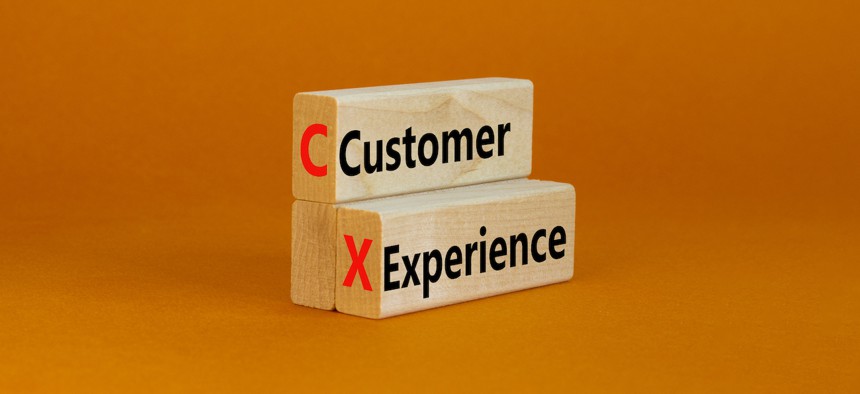
The President’s Management Agenda proposed a roadmap to rebuilding trust in government by delivering excellent, equitable and secure federal services and citizen customer experience Dzmitry Dzemidovich/Getty Images
Does The Government Care About Customer Experience? The Answer May Surprise You.
If done right, a customer experience strategy could help rebuild trust in the federal government.
Have you ever waited in a queue to have a driver’s license renewed and felt your frustration levels rising at the apparent lack of urgency, compassion and accountability? What can you do? You must have a driver’s license, but it is not like you can go somewhere else.
Frustrating experiences like this one contribute to a growing sense that the government is disconnected. Confidence in our system of government has been precipitously declining for the past two decades – Pew Research found approximately 80% of Americans say they do not trust the government and 92% believe it’s unresponsive to the needs of “ordinary” Americans.
The Citizen Customer Experience Mandate
The President’s Management Agenda proposed a roadmap to rebuilding trust in government by delivering excellent, equitable and secure federal services and citizen customer experience. The Biden administration later issued Executive Order 14058 which identified High Impact Service Providers – the 17 federal agencies including departments that oversee education, veteran affairs, social security and more – and outline actions they must take to improve their citizen customer service.
This executive order complements the 21st Century Integrated Digital Experience Act of 2018 and the Office of Management and Budget’s Circular A-11, Section 280. Together, they form a customer experience delivery framework for rebuilding trust in the federal government.
Priority 2 on the President's Management Agenda focuses on three core strategies:
- Improve the service design, digital products and customer-experience management of HISPs by reducing customer burden, addressing inequities, and streamlining processes.
- Design, build, and manage government service delivery for key life experiences – like retirement, disaster recovery, economic hardships – that cut across federal agencies.
- Identify and prioritize the development of federal shared products, services and standards that enable consistent, seamless and secure customer experiences across different HISPs.
Moving from Mandate to Action
Fortunately, many government service providers already have existing, foundational contact center infrastructure designed to manage constituent interactions. It then makes sense that the contact center could serve as the foundation to move transition to a complete citizen customer experience interactions center. Here is a brief checklist of top factors to consider:
Open Service Architecture. The digital transformation required to satisfy the 21stCentury IDEA objectives and deliver excellent, equitable, and secure federal services and customer experience., requires an open CX platform. As a hub of interaction activity, a contact center must have an open design (such as cloud contact centers) to integrate with all the ancillary systems needed to deliver digital products and services, create the convenient access constituents require, and empower employees to deliver the most efficacious and efficient assistance possible.
Digital Ready. OMB A-11 Section 280.7 requires “to the greatest extent practicable” that all services be made available through a digital channel. An analysis of HISP interactions at the end of 2022 shows that 46% of contacts used the phone, 36% used email and 18% used web and mobile methods. Additionally, 54% now use digital channels when requesting help. Therefore, your contact center must not only support digital channels, but also tools to build digitally accessible self-service interactions like searchable knowledge bases, bots and automated guides.
Customer Analytics. The 21st century IDEA act and OMB A-11 Sections 280.10 and 280.14 require agencies to collect data on user behavior and satisfaction to use in the prioritization and design of digital services. While surveys help, we need to observe customer actions and behaviors to really understand what frustrates them. Therefore, your contact center should enable you to learn as much as you can about your customers and their experiences by soliciting survey feedback and analyzing the details of their interactions.
Workforce Empowerment. OMB A-11 Section 280 requires HISPs to measure and report top-level customer satisfaction and trust, which are heavily dependent on empowered agency employees. Regardless of digital enablement, human-to-human interactions still require professionally trained, resources and managed employees. This can be accomplished by providing sufficient resources and interaction information and training, in addition to process automation to expedite task completion, accuracy and consistency.
Journey Orchestration. OMB A-11 Section 280.4 mandates a “human-centered design.” Journey orchestration is a new class of tools that are needed to pull all the underlying capabilities together to create the right interactions and overall journey experience, such as self-service experience for a mobile user that includes a path to elevate that interaction to an agent as needed.
Citizen customer experience is the essential ingredient to help restore confidence and trust between government agencies and the constituents they service. Leaving a constituent with a positive experience is evidence that governments are responsive to the needs of the people they serve and can be trusted to help in moments of need. Executive Order 14058 and supporting directives serve as an excellent template for not only the federal government, but also state and local agencies, in the effort to rebuild trust through delivering better service and experiences.
Agencies may have many of the building blocks they need to improve the experiences they deliver to their constituents. By expanding your contact center into an interactions center, you can re-tool many of your existing investments to deliver better experiences for – and improve your relationships with – your constituents.
Mark Ungerman is a product marketing director at NICE, where he is focused on solutions that help organizations improve customer experience and lifetime value. Mark earned dual graduate degrees in Business and Management of Information Systems and has over 20 years of experience working with successful B2B SaaS companies building and bringing products to market.







